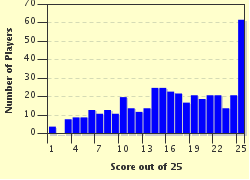Quiz Answer Key and Fun Facts
1. In 1855, Gottfried Hermann named an opera after Toussaint l'Ouverture. This former slave inspired the revolution in a Caribbean nation in 1803, a nation that shook off the French colonial power. Where did this revolt take place?
2. Geronimo Gimenez y Bellido completed in 1890 a zarzuela named after the best known naval battle fought by the Napoleonic fleet. Where did this battle occur in 1805?
3. In 1937 Arthur Honegger dedicated an opera to the presumed son and heir of Napoleon Bonaparte. What was the nickname of Napoleon's son who was born in 1811 and who died in 1832? It is also the title of this opera.
4. Pyotr Ilyich Tchaikovsky completed in 1880 an overture named after the year of the battle at the Berezina - the final defeat of Napoleon's Grand Army, after which he had to leave Russia. In what year did this battle take place? The overture makes use of a frantic rhythm, fragments of the Marseillaise refrain and several cannon shots to recreate the atmosphere of the battle.
5. In 1942, Robert Heger named an opera after Horatio Nelson's mistress. This woman whom he met in Naples was married to an ambassador of one of the leading countries. Who was this woman with whom Nelson committed adultery? She died in 1815, leaving Nelson's daughter Horatia.
6. 1839 saw the first night of one of Friedrich von Flotow's operas. This opera describes the shipwreck of a ship named after a Greek mythological woman (by the way, one of the ugliest females in Greek mythology). The ship sank in 1816 off the coast of Senegal. What was the name of this ship? I ask here for the name as translated in English.
7. Jacques Offenbach specialised in operettas. However, he also composed two serious operas, one of which was first performed in 1881. This opera relates the story of a German author who died in 1822. Few people know that he wrote the poem on which Tchaikovsky's "Nutcracker Suite" was based. What was his name?
8. Juri A. Schaporin completed in 1953 his opera "Die Dekabristen" ("The Decembrists"), named after a revolting party in Russia in 1825. Who was the Czar against whom these Decembrists revolted?
9. Gian-Carlo Menotti composed in 1986 an opera named after a Spanish painter who died in 1828. This painter is perhaps best known for his double portrait of "La Maya": one portrait entirely nude ("La Maya Desnuda", 1800) and one portrait in exactly the same pose, but dressed in contemporary fashion ("La Maya Vestida", 1803). Needless to say that modern illustrators use more frequently the nude portrait to illustrate the painter's talents. What is the name of this painter?
10. Darius Milhaud created in 1950 an opera named after the most important freedom fighter in Latin America. This revolutionary died in 1830. Who was this man?
11. In 1836, a Jewish entrepreneur (first names Nathan Meyer) died. He was the founder of a banking corporation in London. Jerry Bock named in 1970 a musical after this European banker's family. What is the name of this family, almost synonymous in Europe for "opulent"?
12. Vladimir Kobekin composed in 1983 an opera entitled "Puskins Tod" ("Pushkin's Death"). What was the cause of death of this notorious theatre playwright? He died in Russia in 1837.
13. Franz Lehar completed in 1925 an operetta named after a world famous violinist. This Italian violinist was not only a virtuoso at the violin, but was also notorious as a womanizer. Who was this Romantic composer, whose masterpiece is the "Perpetuum Mobile"? He died in 1840.
14. Eugène Gautier created in 1848 an opera which tailed the news headlines of that year. It was entitled "Les Barricades de 1848" and dealt with the series of revolutions which shocked Europe that year. The first revolution of 1848 took place in Paris, on February 22. Was the Communist Manifesto published prior to the Paris Revolt on February 22, 1848?
15. "Tatata tatata tatata ta taa". This is the world famous rhythm of a march composed by Johann Strauss to celebrate the Austrian general who defeated the Sardinian troops at Custoza in 1848. What was his name? By the way, Rene Koering also named a 1988 opera after this general.
16. Franz von Suppé completed in 1866 his overture "Leichte Kavallerie" ("Charge of the Light Brigade"). This overture was inspired by Lord Tennyson's poem "Charge of the Light Brigade". The poem made heroes of the British cavalry regiments who turned, in 1854, a tactical blunder into a strategic victory. Where did this charge take place?
17. August Conradi composed in 1862 an opera named after the first person to publish realistic travel guides. This German author has given his name to the modern travel guide. He died in 1859. Who was this author?
18. 2003 saw the (posthumous) first night of Peter Kreuder's musical named after the Irish woman who performed Spanish dances before the royals and became the mistress to King Ludwig I of Bavaria. She died in 1861. What was this woman's artist's name?
19. Galt MacDermot composed in 1973 a musical about the founder of communism. Who was this German, who published the first part of "Das Kapital" ("The Money") in 1867? He considered that this publication was his masterpiece. "The Capital" part 2 and 3 were published by his collaborator Friedrich Engels.
20. Carl Millöcker created in 1874 a musical named after the supporters of the brother of King Ferdinand VII of Spain. When King Ferdinand finally fathered a daughter in 1830, he declared that his daughter Isabella would inherit the throne. Ferdinand's brother invoked the Salian Law (succession only in the male line) to contest Isabella's inheritance. This led to three civil wars in Spain, the last one between 1872 and 1876. What was the name of Ferdinand's brother?
21. Louis Andriessen composed in 1980 an opera named after Frederic Chopin's mistress. What was her artist's name? She was a novelist and died in 1876. By the way, her artist's name sounds masculine, as was not uncommon in those days.
22. Hervé created in 1889 a ballet named after a notorious event that took place in the same year. What was this event?
23. 1980 saw the first night of a musical by Cy Coleman, dedicated to one of the most famous circus owners. Who was this circus owner, who also invented large-scale publicity? This circus owner died in 1891.
24. Luca Belcastro created in 2001 an opera entitled "1896", to commemorate sporting history. What was the 1896 event that Belcastro wanted to celebrate?
25. Fritz Kreisler dedicated an opera in 1932 after an Austrian Empress, who also inspired three movies starring Romy Schneider. What was the popular name of this Austrian Empress, married to Franz Joseph? She died in 1898.
Source: Author
JanIQ
This quiz was reviewed by FunTrivia editor
Exit10 before going online.
Any errors found in FunTrivia content are routinely corrected through our feedback system.

